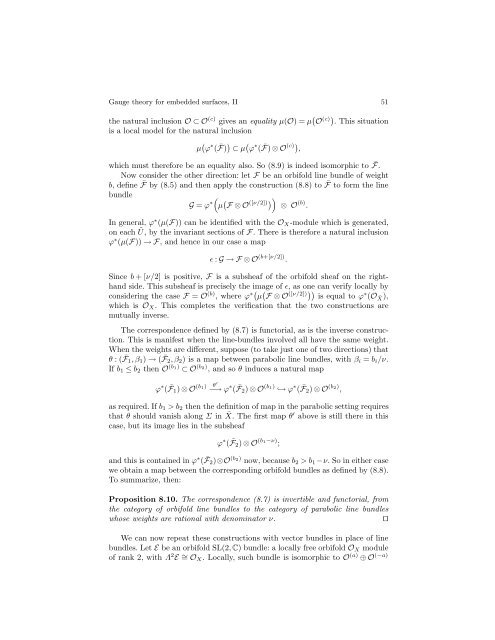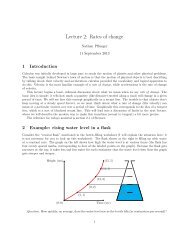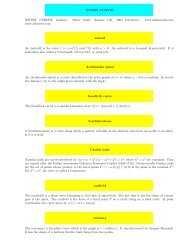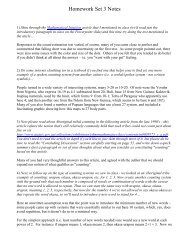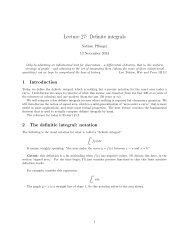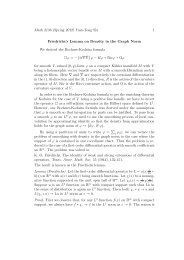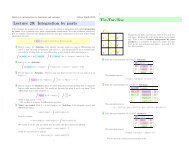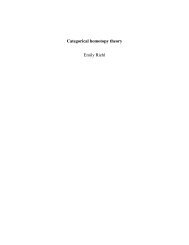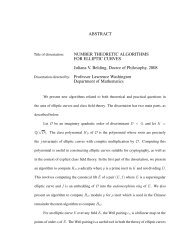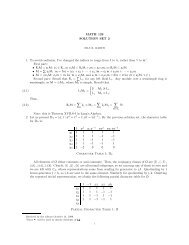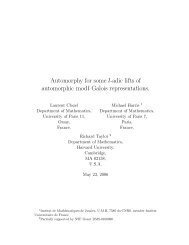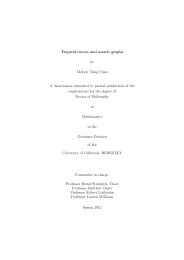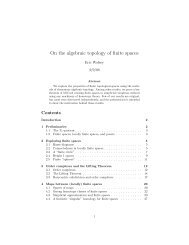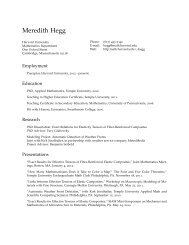Gauge theory for embedded surfaces, II
Gauge theory for embedded surfaces, II
Gauge theory for embedded surfaces, II
Create successful ePaper yourself
Turn your PDF publications into a flip-book with our unique Google optimized e-Paper software.
<strong>Gauge</strong> <strong>theory</strong> <strong>for</strong> <strong>embedded</strong> <strong>surfaces</strong>, <strong>II</strong> 51<br />
the natural inclusion O⊂O (c) gives an equality µ(O)=µ O (c) . This situation<br />
is a local model <strong>for</strong> the natural inclusion<br />
µ ϕ ∗ ( ¯ F) ⊂ µ ϕ ∗ ( ¯ F) ⊗O (c) ,<br />
which must there<strong>for</strong>e be an equality also. So (8.9) is indeed isomorphic to ¯ F.<br />
Now consider the other direction: let F be an orbifold line bundle of weight<br />
b, define ¯ F by (8.5) and then apply the construction (8.8) to ¯ F to <strong>for</strong>m the line<br />
bundle<br />
G = ϕ ∗<br />
µ F⊗O ([ν/2])<br />
⊗O (b) .<br />
In general, ϕ∗ (µ(F)) can be identified with the OX-module which is generated,<br />
on each Ũ, by the invariant sections of F. There is there<strong>for</strong>e a natural inclusion<br />
ϕ∗ (µ(F)) →F, and hence in our case a map<br />
ɛ : G→F⊗O (b+[ν/2]) .<br />
Since b +[ν/2] is positive, F is a subsheaf of the orbifold sheaf on the righthand<br />
side. This subsheaf is precisely the image of ɛ, as one can verify locally by<br />
considering the case F = O (b) ,whereϕ ∗ µ F⊗O ([ν/2]) is equal to ϕ ∗ (O ¯ X),<br />
which is OX. This completes the verification that the two constructions are<br />
mutually inverse.<br />
The correspondence defined by (8.7) is functorial, as is the inverse construction.<br />
This is manifest when the line-bundles involved all have the same weight.<br />
When the weights are different, suppose (to take just one of two directions) that<br />
θ :( ¯ F1,β1)→( ¯ F2,β2) is a map between parabolic line bundles, with βi = bi/ν.<br />
If b1 ≤ b2 then O (b1) ⊂O (b2) ,andsoθinduces a natural map<br />
ϕ ∗ ( ¯ F1) ⊗O (b1) θ ′<br />
−→ ϕ ∗ ( ¯ F 2) ⊗O (b1) ↩→ϕ ∗ ( ¯ F2)⊗O (b2) ,<br />
as required. If b1 >b2 then the definition of map in the parabolic setting requires<br />
that θ should vanish along Σ in ¯ X. The first map θ ′ above is still there in this<br />
case, but its image lies in the subsheaf<br />
ϕ ∗ ( ¯ F2) ⊗O (b1−ν) ;<br />
and this is contained in ϕ ∗ ( ¯ F2)⊗O (b2) now, because b2 >b1−ν.Soineithercase<br />
we obtain a map between the corresponding orbifold bundles as defined by (8.8).<br />
To summarize, then:<br />
Proposition 8.10. The correspondence (8.7) is invertible and functorial, from<br />
the category of orbifold line bundles to the category of parabolic line bundles<br />
whose weights are rational with denominator ν. ⊓⊔<br />
We can now repeat these constructions with vector bundles in place of line<br />
bundles. Let E be an orbifold SL(2, C) bundle: a locally free orbifold OX module<br />
of rank 2, with Λ 2 E ∼ = OX. Locally, such bundle is isomorphic to O (a) ⊕O (−a)


